Haitian Food: Basic Overview
Common Ingredients
Common Cooking Methods
Courses
Meals
Key Taste
Eating Etiquette
Meal Presentation
Culinary Festivals
Influence and Fusion
Popular Types of Haitian Food
-
Soups and Stews
Haitian cuisine offers many rich soups and stews for the main course.
These dishes are typically prepared with vegetables, legumes, and meat or seafood.
Many soups are flavored with strong herbs and spices for vibrant colors and robust flavors.
-
Fried Dishes
Haitian cuisine offers a large number of fried dishes, with meat, fruits, and flour being the main ingredients.
Haitian fried dishes are best enjoyed hot with dipping sauces and pickles as snacks or entrees.
Fried dishes served as street food in Haiti are known as fritay.
-
Desserts
Haitian cuisine offers many delicious desserts for both daily and celebratory meals.
These desserts are often very sweet and diverse in texture, from silky fudge to frozen desserts.
The main ingredients of these dishes include tropical fruits, sugar, flour, nuts, and dairy.
Haitian dishes are specialties closely associated with Haiti, an island country in the Caribbean. Like other countries in the region, Haitian cuisine is a flavorful blend of various culinary influences, including indigenous Taíno, European, and African.
In particular, French food offerings have a significant effect on Haitian cuisine. Due to geographical and historical reasons, dishes in the Dominican Republic also share similarities with Haitian fare.
Popular staples in Haitian cuisine include plantains, root vegetables, seafood, tropical fruits, and poultry. Herbs and spices are used extensively, especially hot chili peppers, imparting a famously robust flavor profile to local fare.
Continue reading to discover more about Haitian traditional food, including its main features, international fame, and healthy aspects.
Next, I will delve into the most well-known 22 dishes in Haiti before covering the principal attributes of Haitian cuisine and suggesting beverages for accompanying local dishes.
22 Most Popular Haitian Dishes with Filters
I have 22 wonderful Haitian dishes just for you. Use advanced filters like alphabetical sorting, main ingredients, taste, cooking methods, dish types, courses, and global popularity to navigate this section more smoothly.
But don’t stop at these options; improve your reading experience with additional filters based on specific culinary styles, such as traditional, national, and street food.
Griot
- National
- Street Food
- Traditional
Griot, also known as griyo, is a beloved Haitian pork dish. It is prepared by marinating pork cubes, slow cooking them, and frying them to achieve a perfect balance of tenderness and crispness.
The marinade for griot citrus juices, garlic, and fiery Scotch bonnet peppers, infusing the meat with a tangy, and spicy flavor profile. This pork dish goes well with vegetables, cold beer, and pikliz, a spicy pickled vegetable relish that adds an extra kick.
If you go to Haiti on special occasions such as Christmas, Easter, and Good Friday, you will easily find groups of Haitians gathering around a succulent serving of griot.
Soup Joumou
- National
- Traditional
Soup joumou, also known as soupe de giraumon, is a popular vegetable soup in Haiti. Locals often prepare it on New Year’s Day, which also marks Haiti’s Independence Day.
Soup joumou is a nutritious blend of beef, cabbage, carrots, turnips, pasta or rice, and calabaza pumpkin (also known as giraumon in Haiti). The last ingredient gives this rich, warming, and savory soup a beautiful bright orange hue.
Since Haiti was freed from French colonial rule in 1804, soup joumou has been a well-liked dish with locals. In 2021, this soup was recognized by UNESCO as an Intangible Culture Heritage of Humanity.
Diri Ak Pwa
- Traditional
Diri ak pwa is a traditional Haitian dish of rice and beans. It reflects the African and indigenous Taíno influences in local cooking, which is evident in the use of rice and pinto beans, black beans, or red kidney beans.
To make diri ak pwa, the rice is often cooked in a flavorful bean sauce enriched with coconut milk, garlic, and spices. This creamy side dish is a versatile accompaniment to pikliz, fish, and meat dishes.
Bannann Peze
- Street Food
Bannann peze, or fried plantains, is a common dish in Haiti. People usually enjoy it as a snack, side dish, or even a street food item, showcasing the widespread popularity of plantains in Haitian as well as Caribbean cuisine.
Green plantains are the best ingredient. They are sliced, fried, flattened, and then fried again until they achieve a golden-brown color and a crispy exterior with a soft, sweet interior.
Pwason Boukannen
- Traditional
Pwason boukannen is a famous grilled fish dish in Haitian cuisine. It typically involves marinating whole fish in a blend of citrus, garlic, and spicy Scotch Bonnet peppers before grilling it over an open flame.
The traditional technique used in preparing pwason boukannen is known as Boukan. The cook splits a wooden stick in half, places the fish between the two halves, ties the halves together at one end to hold the fish in place, and grills it.
With a crispy exterior and a moist, flaky inside, this Haitian grilled fish is a perfect match for pikliz, rice, or fried plantains.
Pikliz
- Traditional
Pikliz is a spicy pickled vegetable relish widely enjoyed in Haiti. Its main ingredients include shredded cabbage, carrots, bell peppers, and chayotes, all soaked and fermented in a mix of white vinegar, lime juice, and hot chili peppers.
“Pikliz” was derived from the French word “piquer”, which means “to sting.” Expect a burst of tangy and spicy flavors when you try this crunchy vegetable garnish.
Haitians always serve pikliz alongside fried or savory foods like griot to add a vibrant kick of flavor and acidity, cutting through the richness of the dishes.
Tchaka
- Traditional
Tchaka, also known as chaka, is a sought-after stew in Haitian cuisine. It has both cultural and religious significance and is considered an important food offering to the god of harvest in the Haitian Vodou religion.
Tchaka primarily consists of corn, red beans, and pork. While the cooking process is simple, it involves simmering these main ingredients for several hours to meld the flavors.
Haitians often prepare tchaka on special occasions, such as All Saints Day, Labor Day, and Independence Day.
Haitian Spaghetti
- Traditional
Haitian spaghetti, also known as espaghetti, is a distinctive take on the classic pasta dish. Locals infuse the original recipe of spaghetti and tomato sauce with smoked herring, hot dog sausage, or fresh watercress.
In addition, Haitian spaghetti features more herbs and spices than other styles of spaghetti, resulting in a bolder and savorier flavor profile. Many people love enjoying this interesting spaghetti dish for a hearty breakfast.
Lambi An Sos Kreyol – Conch In Creole Sauce
- Traditional
Lambi an sos kreyol is a prevalent Haitian dish that stews conch in a rich Creole sauce. Conches are a type of edible sea snail found throughout the Caribbean.
As conch meat is rather tough, it should be tenderized before being simmered in a sauce made from tomatoes, garlic, bell peppers, onions, and seasonings. The contrast between the thick sauce and the chewy conch meat makes for a satisfying meal.
Poulet aux Noix
- Traditional
Poulet aux noix, also known as poul ak nwa, is a well-known Haitian dish of chicken with cashews. It is prepared by browning chicken pieces and slow-cooking them in a rich, nutty sauce made from ground cashews, tomatoes, garlic, onions, and spices.
The contrast between the succulent chicken and creamy and aromatic sauce is the biggest selling point of this Haitian chicken stew. Poulet aux noix pairs beautifully with rice, which soaks up the delicious sauce.
Makawoni au Graten
- Traditional
Makawoni au graten, also known as gratin de macaroni is a Haitian version of mac and cheese. Instead of macaroni and milk like the original version, it features larger pasta varieties (such as penne and rigatoni) and evaporated milk.
Haitian-style mac and cheese is a versatile side dish and a main course for all occasions. Sometimes, this casserole features more types of toppings, namely bell peppers, onions, ham, mustard, and mayonnaise.
Diri Djondjon – Black Mushroom Rice
- Traditional
Diri djondjon, also spelled as diri djon djon, is a common rice dish in Haiti. It is prepared with rice and djondjon mushrooms, a black mushroom variety native to the island.
This mushroom rice dish boasts a rich, earthy flavor and a unique grayish-black color. Diri djondjon first appeared in Northern Haiti before the independence movement and eventually became beloved throughout the island.
Bouyon Bef
- Traditional
Bouyon bef is a rich Haitian beef stew. Locals make it by slow-cooking chunks of beef brisket or shank with carrots, potatoes, cabbage, thyme, Scotch bonnet peppers, and other spices.
While bouyon bef is as robust and umami-packed as any French-style beef stew, this Haitian specialty is often thickened with taro or yam for a distinctive texture. With a side of bread or rice, bouyon bef is the ultimate comfort food for a cold day or when you’re under the weather.
Légume Haïtien
- Traditional
Légume Haïtien, or simply légume, is a flavorful eggplant stew in Haiti. It combines the mild sweetness of mashed or finely chopped eggplants with other vegetables (like spinach and chayote) and, sometimes, meat or seafood.
Garlic, onions, and chili peppers are other essential ingredients to flavor this creamy and balanced stew. A serving of légume Haïtien and rice is among the best options for a Haitian home-cooked meal.
Kalalou
- Traditional
Kalalou is the Haitian take on callaloo, a vegetable stew widely enjoyed in the Caribbean. Its main ingredients include okra, protein (such as beef, crab, or shrimp), tomatoes, thyme, parsley, and more herbs and spices.
The okra thickens this Haitian gumbo-like dish and gives it a distinctive slimy texture, while the other ingredients impart a rich, tangy, earthy, and spicy flavor profile. Kalalou honors the contribution of enslaved Africans who brought okra to Haiti.
Poul Nan Sos
- Traditional
Poul nan sos, literally “chicken in sauce,” is a well-known Haitian dish consisting of chicken cooked in a tomato-based sauce. The chicken is marinated in a spicy marinade before being browned and braised in the tangy sauce.
The tender, succulent texture and robust flavor of poul nan sos are a match made in heaven for starchy side dishes like rice and beans and fried plantains.
Kasav
- Street Food
- Traditional
Kasav is a traditional Haitian flatbread made from grated cassava. With indigenous Taino origins, it dates back to the pre-Columbian era.
To make kasav, the cassava flour is shaped into thin rounds and baked on a griddle, creating crisp flatbread with a mild, nutty flavor. Haitians often top the cassava flatbread with chocolate, peanut butter, or shredded coconut for a delicious snack or light meal.
Akra
- Street Food
- Traditional
Akra, also known as accra, is a well-known snack or appetizer in Haitian cuisine. It is a deep-fried fritter made from a mix of grated taro (alternatively known as malanga), spices, herbs, and sometimes small pieces of salted cod.
Akra boasts a crispy exterior with a soft, chewy interior, tottering between sweet earthiness and savoriness. With tangy and spicy pikliz on the side, these taro-based fritters will provide an excellent eating experience.
Marinad is a type of Haitian fritter similar to akra, but it is mostly made with wheat flour.
Dous Makos
- Traditional
Dous makos is a beloved Haitian fudge originating from the town of Petit-Goâve. It was created in 1939 by Fernand Macos, a Belgian businessman, based on the fudge in his home country.
The Haitian fudge sports a creamy, soft texture derived from milk, sugar, and aromatic spices. Dous makos traditionally has a layered appearance with multiple hues, such as the colors of the Haitian flag (red and blue).
Tablet Nwa
- Street Food
- Traditional
Tablet nwa is a Haitian confection hailing from the commune of Cavaillon in the southern part of the island. It combines roasted cashews with caramelized sugar and ginger into a crunchy, brittle-like treat.
Tablet nwa is a sought-after snack and dessert in rural areas where cashews are most abundant. This Haitian cashew brittle is a common sight at markets and street fairs.
Fresco
- Street Food
Fresco, or shaved ice, is a famous frozen dessert in Haiti. Local vendors prepare it with flavored syrups made from local fruits and sometimes top it with fruit pieces, peanuts, or honey.
Popular fruits for fresco include mangoes, tamarinds, and watermelons. Depending on the type of fruit used, fresco ranges from sweet to tart and comes in many different colors.
During hot and humid months, consuming shaved ice is the favorite Haitian way of cooling down.
Labouyi Bannann
- Traditional
Labouyi bannann, or plantain porridge, is a crowd-pleasing Haitian breakfast dish. It is made by cooking blended or mashed ripe plantains with sugar and milk or water.
Many versions of labouyi bannann also contain vanilla extract or spices for added aroma. This smooth and creamy gluten-free porridge is popular with people of all ages, especially children.
Besides labouyi bannann, Haitians also enjoy another type of porridge made with cornmeal, mayi moulen. This cornmeal porridge is often accompanied by avocado or slices of ripe plantain.
After learning about the most popular dishes in Haiti, have you realized the common threads that link them together? I will address the common features of Haitian cuisine in the next section.
What Are the General Features of Haitian Cuisine?
Learning about the following features of Haitian cuisine will help you understand local dishes better.
Basically, Haitian cuisine is a Creole cuisine, meaning a culinary tradition based on indigenous Taíno, Spanish, French, and African cooking ideas. This fusion of culinary influences characterizes the cuisine of Haiti and much of the Caribbean.
Compared to neighboring countries, Haitian dishes have a stronger French character, highlighting the significant French presence in local cuisine.
Since Haiti borders the Dominican Republic and, to some extent, has a shared history, there are some culinary similarities between the two countries.
The Spanish and French colonization, the transatlantic slave trade, and the post-independence socio-economic landscape all play a significant role in shaping Haitian cuisine.
Haiti’s tropical climate and coastal features contribute to the wide availability of tropical fruits, seafood, and various vegetables.
In the next section, I will recommend several food and drink pairings worth trying in Haiti.
What Beverages to Accompany Haitian Dishes?
While Haitian cuisine has various beverages, the following four options are the best for complementing local fare.
Rum
As a versatile spirit, rum pairs well with a variety of flavors, especially robust and savory dishes. My top picks are griot, pwason boukannen, poul nan sos, and lambi an sos kreyol.
Cocktails
Since Haitian cocktails range from sweet to tangy, these beverages go well with both light and rich dishes like bannann peze, kalalou, and légume Haïtien.
Akasan
Akasan is a sweet corn flour-based drink that is traditionally enjoyed for breakfast or as a snack. This beverage is an excellent match for dishes with similar flavors, including labouyi bannann, kasav, dous makos.
Coffee
Haitian coffee, known for its strong and bold flavors, can be an excellent match for various dishes, such as tablet nwa, dous makos, and makawoni au graten.
What do you think about my Haitian food recommendations? Let me know your feedback in the comment section; your contributions mean a lot to me! Don’t forget to share this list of Haitian dishes with your friends!


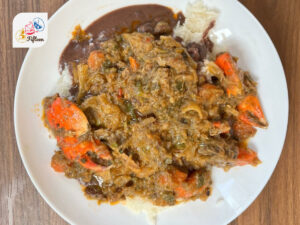
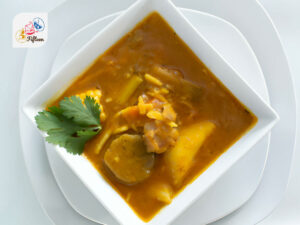
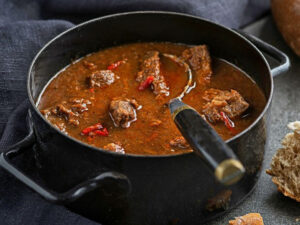

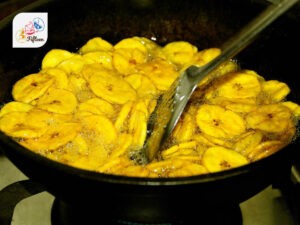
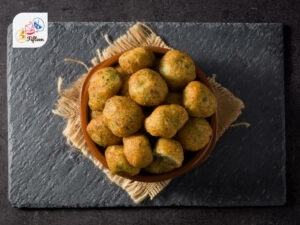
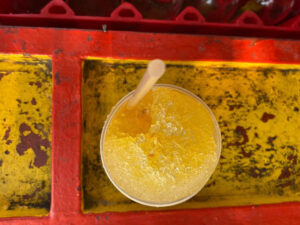


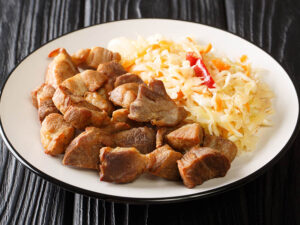
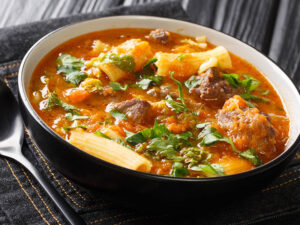
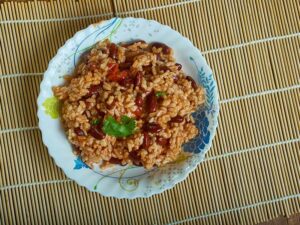
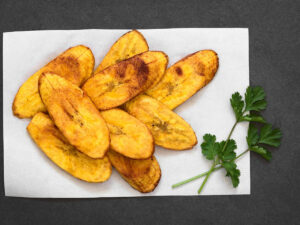
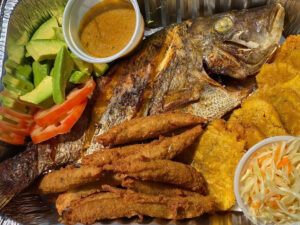
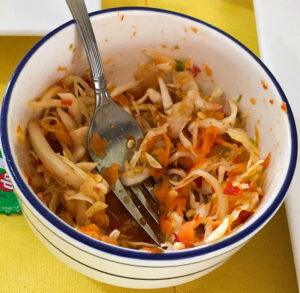
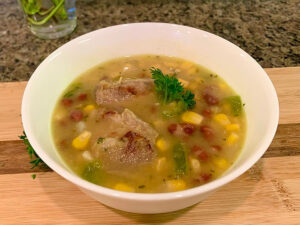
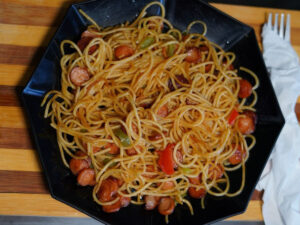
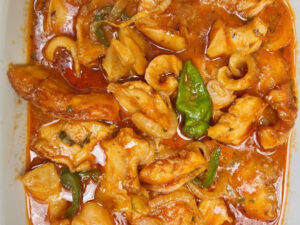
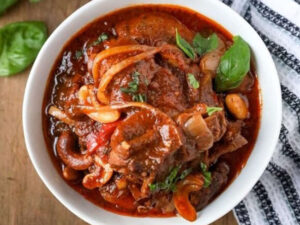

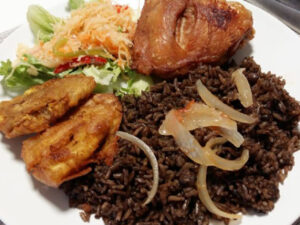
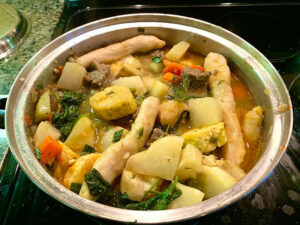
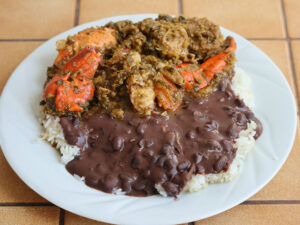
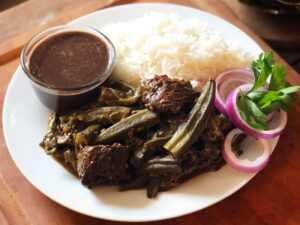

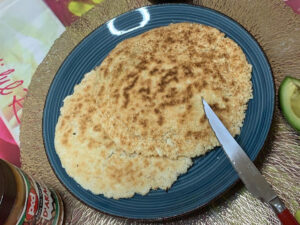
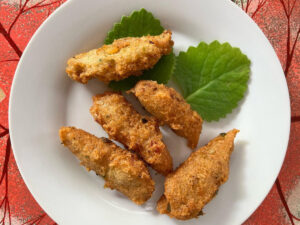

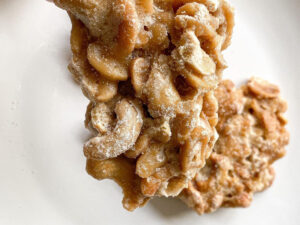

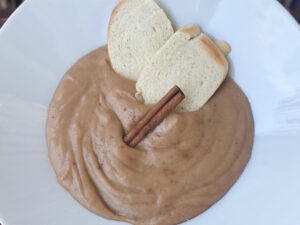
Jamie Scott
Editor in Chief, Senior Content Writer
Expertise
Home Cooking, Meal Planning, Recipe Development, Baking and Pastry, Food Editor, Cooking-video Maker, Western Food Evaluation Expert
Education
Le Cordon Bleu College of Culinary Arts
Local Community College, New York, NY
Jamie Scott is a skilled culinary expert and content creator specializing in Western cuisine. With over 15 years in the culinary field and formal training from Le Cordon Bleu, Paris, Jamie deeply understands how to blend nutrition with delicious flavors. His passion for cooking matches his commitment to making healthy eating accessible and enjoyable.
On Fifteen.net, Jamie brings a fresh perspective to classic dishes and beverages, offering readers insightful recipes, cooking tips, and a fresh view on meal planning that emphasizes taste, health, and simplicity.